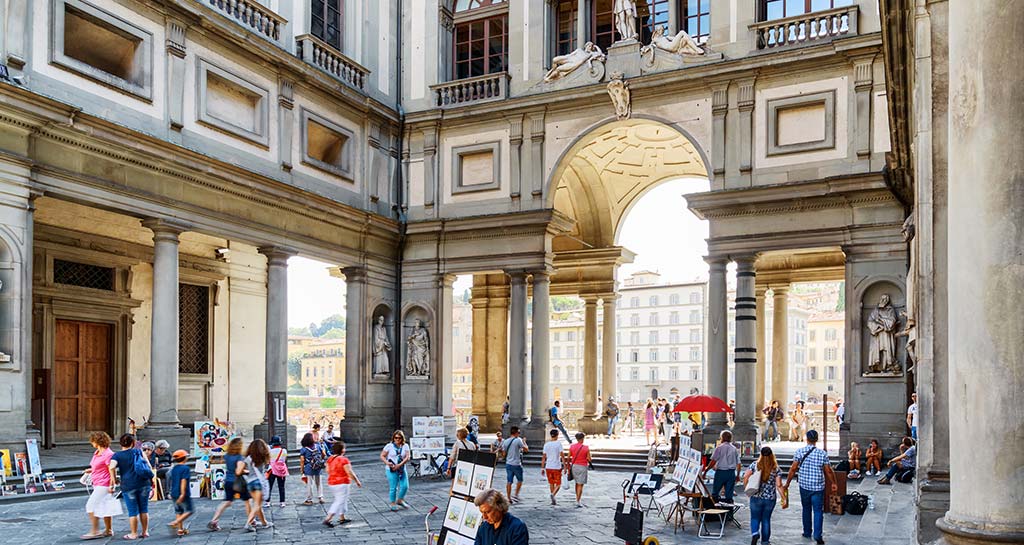The Uffizi Gallery in Florence is one of the most famous art museums in the world. It houses almost the entire collection by the Medici family. Opened in 1769, the museum was first modern museum in the history of Europe. Home to some of the most famous works including masterpieces by Botticelli, Michelangelo, Leonardo da Vinci, Titian, Caravaggio, Uccello, Cosimo, Rubens, Raphael, Rembrandt, and many more.
The gallery was designed by the favorite artist of Cosimo, Giorgio Vasari. It remains in the U-shape that it was designed up to this day. It was initially ordered by Cosimo I de Medici in 1560. However, Vasari died in 1574, and he couldn’t finish the project. The opening was delayed a bit, until Bernardo Bountalenti took over.
Over the years, rooms were designed to exhibit art. While the gallery was finished earlier, it opened for the public for the first time in 1769. With that in mind, here are some facts about the famous gallery.
Home to Renaissance Art
The Gallery is home to the largest collection of Renaissance Art in the world. Many of the iconic masterpieces from world-famous artists are housed in the gallery. Works were also completed round the Italian Renaissance period.
Most of the work in the gallery dates back between 12th and 17th century.
First modern museum in Europe
As mentioned previously, the Gallery is actually the first modern museum in Europe. When the end of the Medici dynasty was approaching, last heiress Anna Maria Luisa De’ Medici decided to donate all of the family treasures to the state of Tuscany. It was her wish that the art collected by the Medici family remain in Tuscany, specifically in Florence. The Medici collected art for more than 300 years. So that is one huge collection.
Millions visit the gallery
The Uffizi Gallery is one of the most popular attractions in the world. There are close to 2 million visitors per year. During peak season, waiting times can reach up to five hours. Plan your trip in advance to avoid the long time.
More than 45 halls of Artwork
The Uffizi Gallery was designed in a U-shape, and has a narrow courtyard between the two rings. The same design remains today. There are more than 45 halls of artwork, spread across two floors of the palace.
If you are short on time, it would be nice to check where the work you want to see is located, so you can get to the spot.
Home to the Longest Corridor in the Land
The artist that started the design of the gallery, also designed the corridor that connects the Gallery to the Pitti Palace. Named the Vasari Corridor, it was built in 1565 specifically for the wedding of a Medici heir. It is one km long, and it is a home to a separate museum. Not many people know about the corridor, and it is only available as a guided tour.
Floods have destroyed the gallery
Because of its location and close proximity to the Arno River, the Gallery has been affected by a number of floods over the years. One of the most damaging was in 1966, which damaged almost all of the art collections in Florence. Many people trying to save their art turned to Uffizi for saving. Nowadays, people that donated their art during the flood in 1966 are known as “mud angels” for their successful effort in preserving art.
Mona Lisa was once in the Uffizi
Mona Lisa was stolen from Louvre in Paris in 1911. For two years, there was no sign of the famous art piece. After two years, the thief Vincenzo Peruggia contacted Italian art collectors to sell the painting. He was arrested during his efforts. Once experts determined that the painting was real, it was temporarily hung at the Uffizi Gallery before it was returned home to Louvre.
Inspired medical conditions
This story is a bit weird and strange, but a medical condition known as the Stendhal Syndrome was actually born in the Uffizi Gallery. Here how the story goes. The famous writer went to visit the Gallery in 1817. He was overwhelmed by the beauty and marvel, and ended up overcome with emotion and sudden illness.
The condition took the name of Stendhal Syndrome. The term is used to describe “psychosomatic pathology in which in front of particularly evocative artworks, it is possible to experience panic attacks, fainting feeling, and general illness”.



